

Jessica Suffield
Debenhams shares plunge 7% after experts warn customers are 'cannibalising' sales by shopping on its website instead of in-store. By Laura Chesters For The Daily Mail Published: 22:00 GMT, 3 December 2015 | Updated: 22:00 GMT, 3 December 2015 Debenhams shares plunged nearly 7 per cent yesterday after experts warned that customers are shopping on its website instead of in its stores – ‘cannibalising’ sales rather than adding to them.
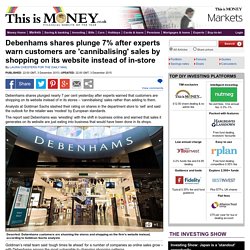
Hidden RFID Tags in your Everyday Life. Shopping trolleys of the future. Future Supermarket Shopping Experience. Future RFID Store. John Lewis and Next Christmas store sales PLUNGE as shoppers flock to the internet. Britain's largest retailers have revealed falling sale stores when compared to Christmas 2014.
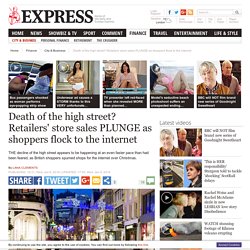
John Lewis said today in-store sales fell by 1.2 per cent in the crucial six weeks to January, compared to the same period last year. But at the same time, online trade jumped by 21.4 per cent and represented 40 per cent of all sales. It comes after Next yesterday revealed store sales had fallen by 0.5 per cent in the 60 days to Christmas Eve, while sales across its Next Directory online and catalogue arm lifted by two per cent. Mannequins are now digitally tracking UK shoppers. Three major UK stores have become the first to trial mannequins embedded with beacon technology, designed to give nearby customers relevant information.
The move comes ahead of planned UK and US expansion from Iconeme, which has headquarters in both countries. You phone will connect you to the best high street deals in 2016. Madhumita Venkataramanan Associate Editor This article was taken from The WIRED World in 2016 -- our fourth annual trends report, a standalone magazine in which our network of expert writers and influencers predicts what's coming next.
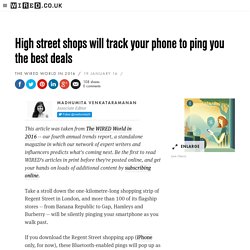
Be the first to read WIRED's articles in print before they're posted online, and get your hands on loads of additional content by subscribing online. Future forecast 2016. Check in commerce. Starwood hotels and resorts and uber join forces for loyalty scheme. Natalie berg the end of loyalty cards. Loyalty apps helping to make life easier. Shopping centre first in uk to adopt beacon technology. Digitalised luxury. Advertising agency staff trial beacon driven loyalty app. Harvey nichols loyalty app. Beacon retail.
The museum beckons beacon technology goes high culture. Beacon of hope. Analysis on third quarter Debenhams sales results. Commenting on the third quarter figures from Debenhams, Mintel’s Director of Retail Richard Perks said: Comment “A sharp slowdown in the third quarter, with like-for-like down from around 3.5% to flat.
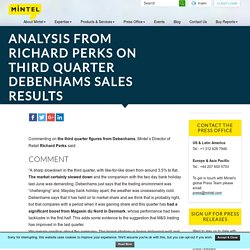
The market certainly slowed down and the comparison with the two day bank holiday last June was demanding. Debenhams just says that the trading environment was “challenging” and, Mayday bank holiday apart, the weather was unseasonably cold. How tracking customers in-store will soon be the norm. At the Fairson's department store, managers can measure the number of people who walk past the store, the number who come through the front door – and this information includes whether or not they went in immediately or were convinced by the shopfront.
Once shoppers are inside the store, managers can find out how many of them walked up to the second floor and compare with the number of people who took the journey to the second floor last week. If more people have gone up this week, they'll probably conclude that the marketing banners that they put up towards the beginning of the week are working. In this scenario, Fairson's is imaginary, but this technology is very real. One firm, the California-based analytics firm Euclid, is hoping to encourage wider take up of tracking technology by offering Euclid Express, which offers retailers a free analytics solution for brick-and-mortar shops.
Why is it free? Personal appsistants 2. Can mobile apps enhance the shopping experience? It is surprising that, since the launch of the App Store in 2008, it has only been in the last five years that high-street retailers have really focused on the need to build apps which offer customers a more immersive and interactive shopping experience, says Geoff Gower, executive creative director at ais London.
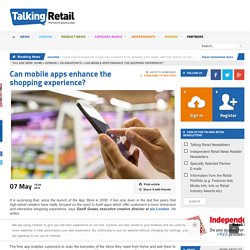
He writes: While some high-street brands, such as Argos and Next, have developed apps which have proven popular with shoppers, others have not fared so well. Now in the hope of making customers’ shopping experience easier, Sainsbury’s has announced it is launching a new app which allows customers to complete an entire in-store shopping trip using their phone. The free app enables customers to scan the barcodes of the items they need from home and add them to a shopping list which is linked to current store prices. When customers enter a Sainsbury’s store, the app will use a Wi-Fi connection to enable a store map on the app, identifying where the items are stocked. Technology Insights – Retail’s Big Show 2015. My Phone is My Life.
How tracking customers in-store will soon be the norm. Consumers hate in-store tracking (but retailers, startups and investors love it) © Time Inc.
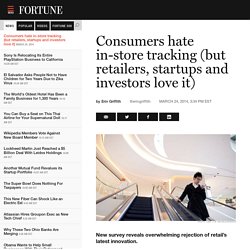
All rights reserved. Fortune.com is a part of the Time.com network of sites. Powered by WordPress.com VIP Email address or Password is incorrect Forgot Password? Want the Full Story? Privacy Policy. In-store analytics: tracking real-world customers just like online shoppers. Retailers are looking for more sophisticated ways to understand customer buying behaviour and want to take advantage of tempting insights from technology and data analytics.
The choices we make as we move through a store reflect what we think about the decisions the retailer has made. We pause at one display – not at another. We choose one aisle to walk down and ignore the next. The Future of Sound. Extreme Engagement – Mass Personalisation. Reinventing Loyalty For The Digital Age – Five Considerations. Owning the Customer the Battle For Customer Data. The Internet of Things – Why It Matters for Marketers. Beacon technology offers plenty of opportunities for retailers. UK retailer House of Fraser announced in August that it will introduce beacon-equipped mannequins in its Aberdeen store to provide customers with a more engaging retail experience.
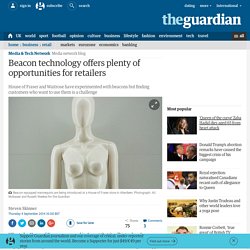
Beacons: Local Retail Game-changing Technology? Beacons, a new technology designed to drive customer loyalty and in-store sales, is growing in popularity among larger retailers. But is it something smaller retailers can use? This article addresses that question, provides details about beacons, and lists five possible reasons local businesses may want to employ the technology.
What Are Beacons? Beacons are small, Bluetooth-enabled devices that attach to a wall or countertop inside a store. Beacons are proximity-based, meaning they send Bluetooth signals to a customer’s smartphone once she is within 50-100 feet of the device, automatically triggering personalized coupons, special offers, and loyalty rewards. Why Target is betting on in-store beacon technology. Target is making a move to infuse its massive retail stores with the perks of online shopping: The company announced it is introducing beacon technology and push notifications to stores, starting with 50 locations. It’s a modest initial roll-out but one the retail industry should pay attention to. Target is joining others — like Simon Mall, Macy’s and Lord & Taylor — that have implemented beacons to combine the intelligence of online shopping with the tangibility of physical retail. Are beacons yesterday's retail technology? It seemed we were on the cusp of something big, unless, as was the case with QR and Foursquare, technology superseded instore beacons before they hit critical mass.
Talk of how beacons, small Bluetooth-enabled transmitters in stores, will revolutionise proximity-based targeting of promotions has been in the air for at least two years now. We’ve even seen some action. Tesco began a beacon trial in April 2014 at its Chelmsford store, integrating the trial with its MyStore app. A month later, Waitrose started a similar test at its concept store in Swindon. When Asda and John Lewis launched tentative trials towards the end of 2014, it seemed we were on the cusp of something big. Bluetooth LE and LED Lighting. Marketing in 2015 – Top Trends. Big Picture Thinking – Customer Experience Strategy 2. 10610692 10152662127677010 8466691793547423452 n. Airport retail. Browse anywhere. Convergence retail. Data marketing. Interactive tech retail 2. Phy gital retail technology social interaction 2. Retail apps challenge 2. Retail challenge. Revelation brands. Save it. Shopping malls changing formats 2. Starbucks espresso journey. The future s mobile.
Birmingham City University - Sign In. Key trends for retail technology in 2015: the rise of hyper-personalisation. This year, customer experience management will be mostly focused on customer personas, rather than portfolios. It is increasingly critical for retailers to innovate in terms of customer experience to keep shoppers engaged. Only by serving the changing needs, preferences and behaviour of the customer, will retailers and brands be able to meet today's hyper-connected consumers on their terms, across all channels of interaction. In-store analytics: tracking real-world customers just like online shoppers: From this, retailers can determine 'hot' and 'cold' zones and, if necessary remodel the store layout to optimise sales opportunities. They can also better understand the level of product lift from shelves and stands. Secondly, it can help retailers know their customers through an understanding of the target market segment that buys which products, and when, and what influences their purchase.
For managers of shopping centres and malls, being able to map footfall gives them information they can use to increase profitability and maximise rent for retail space. Foot traffic and shopper flow analysis can expose the routes shoppers take through the mall, which is very useful information for potential leasing customers, and also for the mall management team wanting to remodel to optimise visitor flow and maximise return visits, not to mention for the setting of price zones according to traffic level.